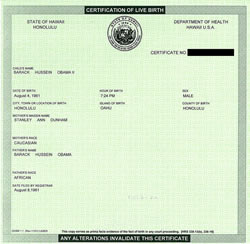 Now that Barack Obama has released a copy of his long-form birth certificate (the supposed Holy Grail of birtherism), the predictable reponses are already airborne: “Is it real?” (launched by The Donald), “What about his school records?” (ditto), and “What took him so long?” (courtesy of The Newt).
Now that Barack Obama has released a copy of his long-form birth certificate (the supposed Holy Grail of birtherism), the predictable reponses are already airborne: “Is it real?” (launched by The Donald), “What about his school records?” (ditto), and “What took him so long?” (courtesy of The Newt).
Since the first two questions are incredibly stupid and the third is only remarkably stupid, I’ll take a stab at answering the third.
 First of all, it never needed to be released. The State of Hawaii’s short-form birth certificate is recognized as valid by the federal government and all other states in the union. It’s the real deal, and no other evidence should be required by any sane person. From this angle, there was no “delay,” because there was never any reason to do it. (Come to think of it, there was no compelling reason to produce the short-form birth certificate, an unprecedented act of presidential deference to noisy persons who are either unhinged haters or cynical operators.)
First of all, it never needed to be released. The State of Hawaii’s short-form birth certificate is recognized as valid by the federal government and all other states in the union. It’s the real deal, and no other evidence should be required by any sane person. From this angle, there was no “delay,” because there was never any reason to do it. (Come to think of it, there was no compelling reason to produce the short-form birth certificate, an unprecedented act of presidential deference to noisy persons who are either unhinged haters or cynical operators.)
But I like to think of it this way. Obama, who professed to being “puzzled” by the whole manufactured controversy (think of it as his Whitewater “scandal”), at first expected it to just go away. But as time passed, I suspect he decided the let the boil on the nation’s backside get as big as possible before he popped it, so as to spray the greatest amount of juice on the greatest number of people. Unfortunately, most of the folks getting doused just think it’s raining. You can’t win an argument with people who think they’re brilliant and doubt any and every piece of evidence that undercuts their belief. The belief comes first, last, and always. That’s what makes them brilliant: their brilliant beliefs. Evidence is for dopes like Obama and me.
Of course, the birther pseudocontroversy is a proxy for aspects of Obama that some Americans don’t like but can’t say in public—for instance, his race (or mixed-race, which may be more troubling to some); or would make them look intolerant—“He’s a Muslim,” “He spent too much time in strange, scary countries while he was growing up,” etc. These are actually facts, so we can’t say birthers ignore facts. It’s just the facts they detest are things most Americans have learned to accept (or even embrace), and so they need to be a bit roundabout in attacking the man. Hence the apparent obsession with a dumb technicality—it’s not about birth certificates at all. Obama has to know this, realizing that each time he responds to them he helps keep the stupid issue alive.
Obama says birtherism is “silliness” distracting us from the real issues that the government should be focusing on, real problems that need to be solved. On the surface, it is. It’s a silly whopper. But some silly whoppers run deep, and this is one of them. Ronald Reagan told tons of silly whoppers. It got him two destructive terms in the White House and a golden legacy that still astonishes me.
This headline from 2009 is just the closing touch I needed:
Afterbirthers Demand To See Obama’s Placenta
On second thought, this one is better, and much fresher:
Trump Unable To Produce Certificate
Proving He’s Not A Festering Pile Of Shit
Addendum 2011.04.28: A quick roundup of the birthers who still don’t believe, with a great quote from Jonathan Swift: “You cannot reason a person out of something they were not reasoned into.” (That may be a paraphrase—Wikiquote has it thus: “… reasoning will never make a man correct an ill opinion, which by reasoning he never acquired …”)
 (though not in this format).
(though not in this format).


































